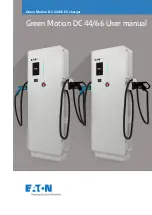
4
Battery voltage
Battery internal gas pressure
Battery temperature
Battery voltage
2
V
Overcharge range
Battery temperature 60 ˚C
120-minute timer
Ni-Cd Battery temperature
Charging time
Battery internal
gas pressure
Battery temperature 55 ˚C
dT/dt
Ni-MH Battery
temperature
4-1-4. 3-way overcharge protection system
Overcharge protection is ensured by a (A) system or dT/dt system (for Ni-MH battery), (B) built-in battery
temperature sensor (thermistor) and (C) a timer.
Fig. 6 Relationships of time, voltage, temperature and gas pressure while charging
(A) • : This detects the increase in battery voltage at the end of charging using the value and suspends
charging.
dT/dt : This system is applicable to Ni-MH batteries. This detects the variation of Ni-MH battery temperature
by the value dT/dt at the end of charging and suspends charging.
(B) • Built-in battery temperature sensor : In the event both the system and the dT/dt system fail to detect
completion of recharging, recharging is automatically stopped when the battery temperature reaches 60 ˚C in
the case of the nickel cadmium (Ni-Cd) batteries or 55 ˚C in the case of the nickel metal hydride (Ni-MH)
batteries.
(C) • Timer : Should both the system, dT/dt system and the temperature sensor fail, the timer automatically
stops charging within 120 minutes from the beginning of charging.
(Note 2) The voltage of the battery increases during charging and begins to fall when further charging is not
possible. The system detects the point where the voltage begins to fall, and suspends charging
to protect the battery from overcharging.
(Note 3) The temperature rise during charging of a Ni-MH battery is higher than with a Ni-Cd battery, and a
sudden temperature rise occurs just before the battery is fully charged. The dT/dt system detects the
point where the temperature rises suddenly and suspends charging to minimize the temperature rise.
(Note 4) As shown in Fig. 7, the pressure of gas generated after a battery has become fully charged rises
rapidly to cause high temperature and high gas pressure that degrade the effectiveness of the
battery. If charging is allowed to continue, the pressure of the gas will activate the safety valve in the
battery, and the electrolyte will begin leaking.
Содержание UC 14YFA
Страница 23: ......







































